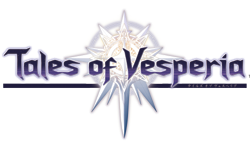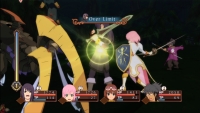|
|

|
PLATFORM
|
Xbox 360
|
BATTLE SYSTEM
|

|
INTERACTION
|

|
ORIGINALITY
|

|
STORY
|

|
MUSIC & SOUND
|

|
VISUALS
|

|
CHALLENGE
|
Adjustable
|
COMPLETION TIME
|
40-60 Hours
|
|
OVERALL

|
+ Great cast of characters
+ Fast, fun combat
+ Gorgeous visuals
- Plot is a bit of a disappointment
- Combat has not evolved in any way
|
Click here for scoring definitions
|
|
|
Buying and playing a Tales game is similar to inviting an old friend to dinner: you know exactly how the night will go down. Some may criticize the series for this, while others no doubt find this fact comforting. Tales of Vesperia is the first Tales game to be released for current-generation consoles, and marks the tenth anniversary of the series in North America. The game's plot is somewhat lacking in originality, and the combat offers nothing new to the series, but Namco's latest Tales effort remains a solid, entertaining, and graphically impressive role-playing experience.
Tales of Vesperia tells the story of Yuri Lowell, a former member of the Imperial Knights who is driven to resign by the idealistic differences he has with the Empire. Early in the game, he sets off after a thief who steals from the lower quarter of his home city, the Imperial Capital. The chase causes him to meet up with a princess named Estelle. Claiming she has a message for Flynn, Yuri's childhood friend and a current member of the Imperial Knights, Yuri agrees to take her with him to the world outside. On their way they make a variety of new friends, fight a lot of baddies, and become caught up in a conflict that threatens the entire world.
No doubt about it, the plot in Tales of Vesperia is pretty tried-and-true. Princesses are captured, empires are evil, civilizations are lost; the list could go on. But, while this is occasionally perturbing, the story is easily forgiven for being well-told, and, ultimately, quite entertaining. The pacing of the plot is excellent. The characters are moved from place to place quickly, without an excess of dull backtracking, fetch quests, or "town crawling." Although, from time to time, the plot has a problem with focus -- often, Yuri and his gang set out to do one thing and end up doing several entirely different things before the escapade is over. The script is fairly well-written overall, and many scenes stand out with sharply written dialogue. However, there are a fair number of cringe-inducing scenes as well; at times the player may skip certain text balloons to spare the pain of hearing it spoken. There's quite a bit of dialogue in the game, with much of it coming from the signature skits that pop up on a regular basis. These can be ignored or skipped, but there's a great deal of character development and entertaining banter to be missed.
As in all Tales games, the cast and characters are what make the experience here. Everyone in the party is well-developed and defined, and they make the adventure interesting. Yuri, in particular, is brilliant as protagonist of this adventure. His outward appearance as a hardened ex-knight is cool enough, but as the story progresses, it's revealed that there's quite a bit more depth to his character. His rivalrous relationship with Flynn is wonderfully handled, and is one of the best aspects of the story. The guild member Raven provides much of the comic relief during the game, but it's shown that there's a serious side to him as well. The only character who manages to be almost entirely a nuisance is little Karol, the obligatory male prepubescent with a voice actress who doesn't even try to hide the fact that she's female. The only thing that's missing from this ensemble is a truly good villain. Sure, there are bad guys throughout, but Vesperia is lacking a single, solid villainous presence for gamers to hate.
 They're actually dueling here.
They're actually dueling here.
|
|
When Yuri and friends set out on their adventures, they inevitably have to fight a lot of monsters on the way. Like Tales of the Abyss (and Tales of Symphonia before that), all encounters are visible on-screen, and can often be avoided. When a foe is engaged, the action turns to a three-dimensional combat arena in which four members of the party will take part in battle. The player can only directly control one character at a time; the other three are controlled by artificial intelligence. But worry not, the game's AI is actually quite capable, and an extensive strategy menu allows for in-depth customization of the fighters' actions. Combat is real-time, and there are several different actions to choose from; attack with the currently equipped weapon, perform special attacks called Artes (which consume tech points), and block enemy attacks to significantly reduce damage taken. By linking standard attacks and Artes, combos are strung together. There are varying levels of Artes as well, and only certain types can be linked consecutively. For example, a Base Arte can be followed by an Arcane Art, but it cannot be followed by another Base Arte.
If this sounds similar to the combat found in previous Tales games, that's because it is. The only new addition to speak of is the Fatal Strike. Every Arte in the game has a certain color attribute, denoted by a red, green, or blue arrow on the menu screen. When a certain number of Artes sharing the same attribute have been used on an enemy, a glowing glyph may appear. Instantly tapping the right trigger will perform a Fatal Strike. Fatal Strikes aren't difficult to pull off, but they aren't easy either. When a Fatal Strike is successfully triggered, it is powerful enough to kill a normal enemy instantly, and deal great damage to bosses. (Incidentally, an Arte's color attribute is separate from any Elemental attribute it may have.) In addition to Fatal Strikes, there are a few other super-powerful attacks available, both returning from Tales of the Abyss: Burst Artes and Arcane Artes, which can only be performed in Over Limit mode. Over Limit mode can be activated by hitting the D-pad when the O.L. meter has been filled to a certain point. As per usual, the meter is filled by both giving and receiving damage in battle. Strangely, the combat controls in Tales of Vesperia don't seem quite as tight as they were in previous entries. When trying to guard, there's an annoying split-second lag between pressing the X button and when the character on-screen puts up his guard. It's the same when pressing the attack button, though slightly less noticable. In truth, it's not enough of a problem to damage the experience, but it can become annoying during boss battles when things become especially hectic.
While the combat in Tales of Vesperia is certainly nothing new, it remains a fast, furious, and fun system to play around with. Normal encounters are quickly resolved, and boss battles (especially against other human characters) can be remarkably epic. Even if they don't require much in the way of strategy, they force players to be quick on their feet and keep a level head under fire. The difficulty in Vesperia has been ramped up compared to previous entries in the series, so it is crucial to learn the combat system in and out.
 Bit of an overkill in this case.
Bit of an overkill in this case.
|
|
There is a fair amount of strategizing and decision-making to be done outside of battle as well. Characters learn skills through the weapons they equip in a system that is all but identical to games such as Final Fantasy IX and Lost Odyssey. Skills are separate from Artes and there are a mind-boggling number that can be learned, with a variety of different uses. Some of them directly enhance combat prowess by raising attack power or adding extra hits to a base combo. Others allow different types of Artes to be linked together, or for certain Artes to be altered. Naturally, the number of skills that can be equipped at a given time is limited, so careful decisions are necessary. There's nothing terribly exciting about this system. it's been seen many times before. But it gets the job done, and allows for a good degree of customization.
Outside of the skill system, the Synthesis and Cooking systems deserve brief mention. At nearly every market in the game, there is the option to synthesize items, weapons, armor, and more. Enemies drop synthesis items, and if all the appropriate materials are present, then a certain item may be available to synthesize. Even if the player doesn't have the appropriate materials, with a few button presses the game will reveal where to find the materials needed to make it. It's a very easy system to use, and certainly doesn't have the depth to it present in games such as Dragon Quest VIII. The cooking system, a staple of the Tales series, is present once again. The player will run into the mysterious Wonder Chef numerous times during the course of the journey, and the chef will oblige by teaching the player a new recipe. Certain dishes restore HP and TP, while others may raise attack power or defense temporarily. It's fun to play around with sometimes, but it's hardly necessary to progress through the game.
There is plenty to look at during the course of the adventure, that much is certain. This is the first Tales game to appear on a current-generation console, and Vesperia certainly looks the part. Character models (designed by the legendary Kosuke Fujishima) are beautifully designed, sharp, and colorful. As per usual, battles are lavish, beautifully animated affairs. Spells and special attacks look fantastic, and everything is animated smoothly. Environments aren't exactly dripping in detail, but that's not to say that they're lacking. Vesperia journeys to a number of colorful and artfully imagined locales, ranging from bustling Imperial cities to overgrown ruins to ghost ships. Also worth mentioning are the anime cutscenes that litter the game. These cutscenes are always a wonder to behold, and there are considerably more of them in Vesperia than there has been in any Tales game before it.
The audio side of the game doesn't impress quite as much as the visuals, but manages to hold its own. Voice acting is quite solid for the most part, although there's really nothing amazing about it. However, Troy Baker's performance as Yuri Lowell deserves especial mention here; he always hits the right notes at the right time, and entirely avoids the pitfall of overacting. Most of the voice acting present in the game can be called average, and at the very least it avoids being painful to the ears. (With the exception of Karol's actress, as mentioned before.) The musical score in the game is less impressive still, with Motoi Sakuraba churning out a soundtrack that manages to fit a given environment or battle, but does nothing more. There really isn't a memorable track to be found in Tales of Vesperia outside of Bonnie Pink's theme song. Furthermore, the game maintains the annoying Tales tradition of utilizing certain musical pieces for dialogue scenes over and over again.
Other than enhanced graphics, Tales of Vesperia brings almost nothing new to the series. Considering that this is the series' first current-gen appearance, it almost feels like a missed opportunity. And yet, it's hard to complain about tradition when it's done right. The story, while fairly typical, has some great moments and a great cast of characters. The combat is what we've seen before, but as always, it's fast and it's fun. A fan of the Tales series should not hesitate to give this a shot, nor should anyone who enjoys a good anime-style RPG.
Review Archives
|









